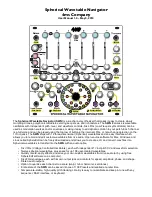
This unit can send and receive the MIDI messages indicated by
“O” in the MIDI Implementation Chart on page 20. You can use
these MIDI message external device. For details, see “MIDI
Implementation” (p. 12). Read on for an explanation of some typ-
ical functions that you can use.
■
Changing Patches .............................................
This unit has more than 128 built-in Patches, so it’s not possible
to select every Patch with just Program Change messages. For
this reason, Patches can be switched by using Program Change
messages together with Bank Select messages.
A Bank Select message is a combination of Controller Number 0
and Controller Number 32, but this unit always treats the value
of Controller Number 32 as “0” (zero).
When the unit is shipped from the factory, you can select Patches
from 1 to 128 with a value of 80 for Controller Number 0 and
with the Program Number. You can select Patches from 129 to
255 with a value of 81 for Controller Number 0 and with the
Program Number. This is shown in the following figure.
To change a Patch, send MIDI messages from the external device
in the sequence shown below.
Controller Number 0
Value: 80 (Patches 1 to 128)
Value: 81 (Patches 129 to 256)
Controller Number 32
Value: 0
Program Number
Value: 1 to 128
The Patch is changed when the MIDI messages are received in
this sequence. If you sent only a Program Number without send-
ing Controller Number 0, the previously sent value for
Controller Number 0 and the Program Number just sent are
used to choose the Patch.
* When shipped from the factory, the unit is set up for switching
patches with a value of 80 or 81 for Controller Number 0, but
you can modify the Bank Sel parameter (p. 5) to change the
value for Controller Number 0 that is used to switch Patches.
* The number of Patches varies from one model to another.
* If you specify a Bank in which a Patch is not assigned, the mes-
sage “
” (no Patch) appears on the display and no sound
is played. Press the Value button to return to the previous dis-
play. Refer to the owner’s manual for the particular model you
are using for descriptions of the Patches assigned to the differ-
ent Banks.
■
Changing Performances....................................
You can also use Program Change messages to change the
Performance. When shipped from the factory, however, the unit
was set so this feature is disabled. See “MIDI Implementation”
(p. 16: Control channel) for more details.
■
Changing the Patch Table .................................
This unit has two Patch Tables. Patch Table 1 (details of which
can be found in the owner’s manuals for the particular model
that you’re using) is enabled when the unit’s power is switched
on, but changes to Patch Table 2 when a General MIDI System
On or GS Reset message is received. You can switch back to
Patch Table 1 by sending a General MIDI System Off or Exit GS
message to the unit; or by switching the power off, then on
again.
See the owner’s manual for the particular model that you’re
using for information on the Patch Table 2.
* This unit receives GS reset or GM system on message when it
is set to Patch mode, automatically change to Performance
mode.
* If SysEx parameter (p.5) set to “oFF” or “PAr,” this unit
doesn’t change to Patch Table 2 because of this unit doesn’t
receive GM system on and GS reset message.
Important!
When Patch Table 2 has been selected, a dot appears in the lower
left corner of the display, as shown below.
1
2
3
127
128
126
0
1
2
3
80
81
126
127
Program Number
Value of Controller Number 0
8
Using MIDI Messages to Control the Unit













































